Chapter 3: The Empirical Reality of Contemporary Libel Litigation
A. Introduction
It is the aim of this Chapter to quantify empirically what happens in defamation cases against the news media in a broader and more complete context than the Media Law Resource Center (“MLRC”) has undertaken in the past and to dispel some misconceptions about what conclusions can be drawn from our previously published trial data. In Justice Gorsuch’s dissent from the denial of certiorari in Berisha v. Lawson,[1] questioning New York Times Co. v. Sullivan and its impact on libel plaintiffs, he relies in part on an analysis by Professor David A. Logan, which cites to MLRC’s media trial data in support of his theory about Sullivan’s long-term impact.[2] A prominent aspect of the argument advanced by Professor Logan is that a sharp drop in the number of trials against the media between the 1980s and recent years, documented in the MLRC study, demonstrates that “over time the actual malice standard has evolved from a high bar to recovery into an effective immunity from liability.”[3] The evidence, however, shows that there is no cause-and-effect relationship between Sullivan and this perceived imbalance. First, the supposition ignores the dramatic decrease in all civil trials over the past few decades (hardly limited to defamation cases), which is in nearly precise sync with the decline in media trials. There is abundant scholarship explaining that trials have been largely replaced by settlements, facilitated, in part, by expanded mediation and ADR, broader discovery rules, higher litigation costs, and other factors that incentivize the risk-averse strategy of avoiding trials. Whatever the cause, the dramatic decline in trials is across the board. Next, only some media trials (about half) are tried under the actual malice standard that was prescribed by Sullivan and its progeny. The other media trials in MLRC’s 37-year study were tried under a different legal standard, most commonly negligence. Cases tried under the actual malice standard are declining at approximately the same rate as cases tried under a different legal standard. All of this raises the question of how Sullivan can be the cause of the reduction in the number of trials in cases where the legal standard it prescribes is not applicable? The plain answer is that there is no evidence that Sullivan is impacting the year-to-year declines in any media trials.
Critics of New York Times Co. v. Sullivan also point to plaintiffs’ poor performance defending trial awards on appeal. But media defendants have a good track record in all appeals, and actual malice only plays a role in some of them. Indeed, recent trends from roughly the past two decades show plaintiffs in actual malice cases outperformed their non-actual-malice counterparts defending cases on the appeal of awards. The fact is that there are a wide range of speech-protective elements and defenses to a libel cause of action unrelated to actual malice, that are commonly utilized to defend cases brought against the media. Some of the most common libel defenses[4] are the fair report privilege, opinion, rhetorical hyperbole, defamatory meaning, the “of and concerning” requirement, and substantial truth. These are not technicalities used by media defendants to escape liability, but rigorous legal requirements that separate free speech from statements that cause unjustifiable reputational harm. Newsroom lawyers across the country counsel reporters on these principles every day to help keep their journalism out of the courtroom in the first place. While journalists who have received training and/or prepublication review from lawyers may still find their work challenged as libelous in a lawsuit – and of course, journalists sometimes make mistakes – it should be no surprise that cases brought against adequately vetted and journalistically sound reporting are often subject to dismissal by motion practice early in the proceedings. Where cases involving quality journalism do make it to trial, resulting in an award, it is not revelatory that damages awards are often reversed or modified on appeal.
Since Professor Logan (and by extension Justice Gorsuch) relies on MLRC trial data, it is essential to point out that, to be included in MLRC’s study, cases resulting in a trial[5] had to have been brought against a “media entity or media-affiliated individual”[6] as MLRC defines those terms. A “media entity” generally includes: “television, cable and satellite broadcasters; newspaper, magazine and book publishers; and movie and music producers and distributors.”[7] Website operators or bloggers can also be included in the study, but “only where the person or entity sued is a professional in the presentation of the material at issue, and where the site is at least attempting to receive a significant amount of revenue from the site.”[8] With 37 years of data covering 629 trials, we have only to-date included five trials in cases brought against internet companies or sites that have met this definition.[9] Our study does not include trials involving content from personal websites, social media commentary, internet trolls, or “virtually anyone who can publish anything for immediate consumption virtually anywhere around the world,” as Justice Gorsuch describes it.[10] Thus, it is important to point out that most of the concerns that Justices Thomas and Gorsuch express in their dissents in Berisha about disinformation on the internet and social media[11] are not examined in MLRC’s trial study, and the results do not speak to the issue of whether the law, much less New York Times Co. v. Sullivan, is adequately calibrated to address those concerns.[12] The vast majority of the outlets sued in the trials covered by the MLRC study – 92% – fall into just four categories: newspapers, magazines, television broadcasters and radio broadcasters.[13] One can surmise that a majority of the outlets in MLRC’s trial study employ professional journalists and/or in-house and outside media lawyers, publish news and entertainment content under their own names and have strong financial incentives to avoid content liability and litigation expenses from lawsuits. The trial statistics in MLRC reports speak only to their success at trial, and on appeal from trial. Thus, reliance on the MLRC trial study, which quantifies the litigation success among organizations predominantly engaged in journalism, to prove a point about an alleged failure of legal doctrine to tackle falsehood and rumor on social media, would be akin to using a weather report from New York City to prove it’s raining in London.
Because MLRC’s most long-term and up-to-date data relates only to media trials and not the vast majority of media cases that never make it to trial, in connection with this report we asked major news media companies to complete a survey about each of the libel complaints they received since 2009.[14] Out of some 246 cases brought against these companies, and 177 dispositive motions prior to trial, defendants had a high win rate of 75% (including results on appeal), but only 16% of the motions were defense wins (also including appeal) on the issue of actual malice, very much challenging the perception that it is Sullivan that is the root cause of these defense victories. Moreover, while the number of trials has gone down, there is no evidence that media libel complaints have gone down, either in the long-term since Sullivan, or in the short-term, with some evidence that the number of cases went up in the late 2010s. Furthermore, while trials are very rare, among the media companies we surveyed, settlements have replaced them in many cases. We discuss those results and some other recently conducted research in more detail below.
B. The Decrease in Media Trials is Unrelated to Sullivan
Legal observers have, for some time, been trying to make sense of the cause of what has been called the “disappearing jury trial.”[15] In the federal courts, where case data is most reliable over the decades, the rate of civil trials has declined markedly since the era when Sullivan was decided. In “1962, trials still accounted for roughly 12 percent of all civil dispositions in federal court. But 40 years later, the rate of disposition by trial in civil cases had fallen to less than 2 percent, even as the total number of civil dispositions grew dramatically. [By 2017,] approximately 1 percent of all civil cases filed in federal court [were] resolved by trial – the jury trial disposition rate [was] approximately 0.7 percent, and the bench trial disposition rate [was] even lower.”[16] In the federal courts, defamation cases have accounted for approximately three tenths of a percent of civil cases filed since 1970,[17] so it can hardly be said that Sullivan or other speech-protective legal doctrines applicable to libel cases have any connection to the overall decline in federal civil trials.
What has been observed since the late 1980s is “not only a continuation in the shrinkage of percentage of cases that go to trial, but a shrinkage of the absolute number of cases that go to trial.”[18] The overall decline in all civil trials is highly correlated with the decreases in media trials documented in MLRC’s 37-year study of media trials and damages.[19] The full set of MLRC trial data, relied upon by Justice Gorsuch and Professor Logan, is graphed below in Chart 1:

A trend line is drawn through the center of the data points to represent the best linear fit for the data.[20] In federal court data, the most reliable (and perhaps only) source of trial data[21] over this 37-year period, civil trials have declined in a remarkably similar fashion, as represented by Chart 2.[22] Indeed, if you compare the average number of media trials and federal civil trials in 1980s, and measure their decline by the average number of media trials and federal civil trials in the first seven years of the 2010s,[23] respectively, there is only a small difference in the percentage of decline: 75% in the case of media trials and 70% in the case of federal trials, as described in Table 1 below.
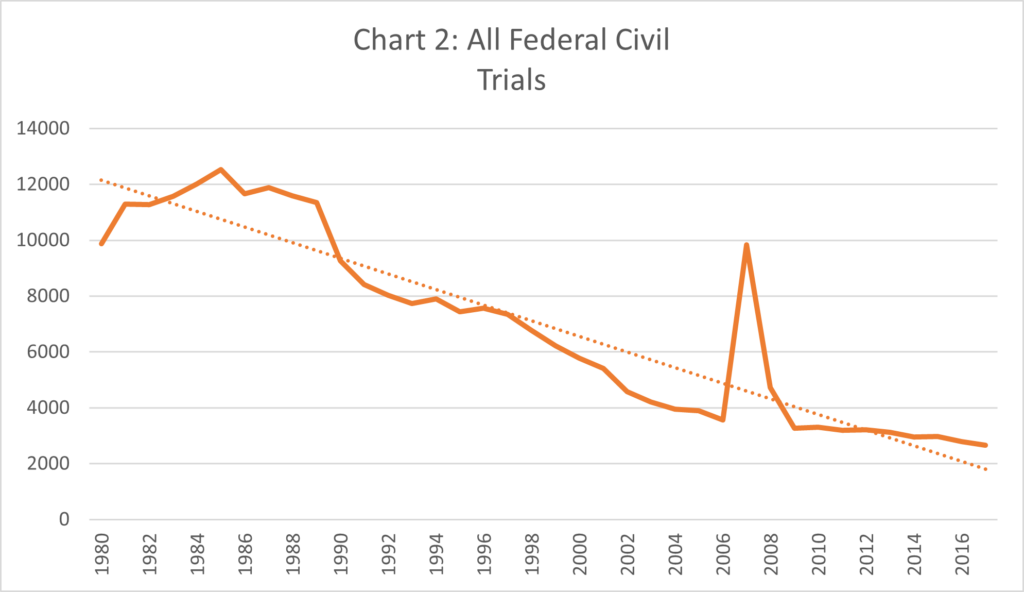
Table 1: Decline in Avg. No. Media Trials vs.
Avg. No. Federal Civil Trials – 1980s to 2010s.

When the two graphs of media trials and federal trials are converted to percentage of change since 1980 and superimposed upon one another, the two trend lines run in extraordinary proximity and parallel to one another as depicted in Chart 3 below. The data used to plot Charts 1-3 is included in Appendix I, Table A.[24]
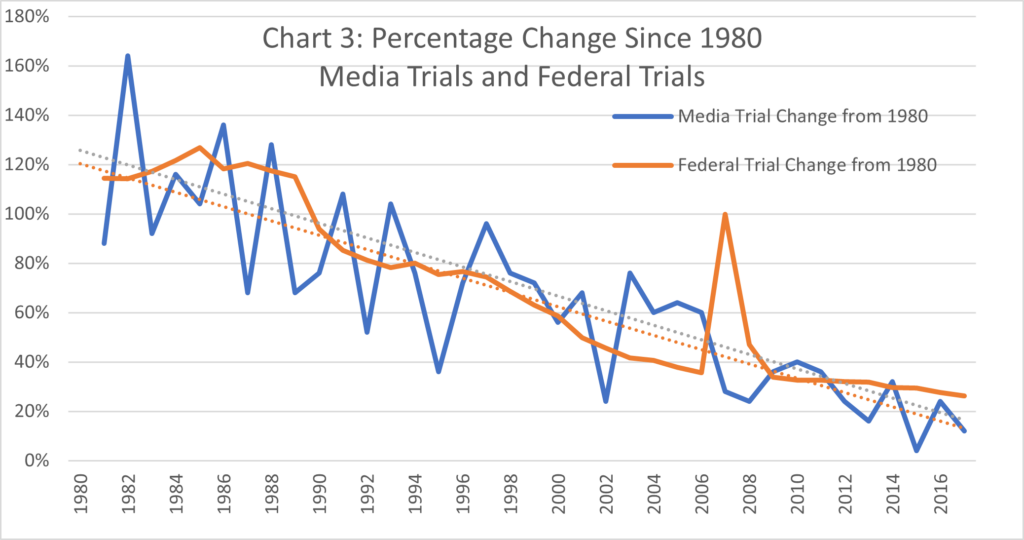
Although there is less comprehensive state data, similar declines in state trials have been reported. For example, the National Center for State Courts reported that in a study of twenty-four state jurisdictions, trials declined by 47.5% from 2000 to 2009.[25] That very much echoes declines in MLRC’s study of media trials, in which all media trials declined from 18 in 2000 to 9 in 2009 (a 50% decline), and state media trials declined from 11 and 14, in 2000 and 2001, respectively, to 6 and 8, in 2008 and 2009, respectively (a 44% decline between 2000-01 and 2008-09).[26]
MLRC does not have data on media trials prior to the 1980s, including the first 16 years after Sullivan was decided in 1964. But given the evidence that the number of media trials, year over year, are highly correlated with changes in the overall number of civil trials, one could certainly make the supposition that media trials were on the increase until the peak in all civil trials in the mid-1980s. One of the leading scholars studying the phenomenon of the declining American trial, Marc Galanter, published the bar graph below (Chart 4) depicting the number of federal civil trials from 1962 to 2010, with a clear peak in 1985.[27]
Chart 4

There is certainly no evidence, as one might infer from Justice Gorsuch’s reliance on Professor Logan’s arguments, that media trials were at peak in the 1960s before Sullivan and the actual malice standard took root and gradually caused media trials to decline over the next 50+ years. There is some evidence that libel cases, not necessarily trials, did peak in the 1980s – years in which trials in libel cases like those brought by General William Westmoreland[28] and then-former Israeli Defense Minister Ariel Sharon,[29] were headline news. The number of libel cases against the media seems to have fluctuated in the decades that followed. Data supporting that point is discussed in Section D infra.
Even if data pointing to the decrease in media trials were a good benchmark for showing that libel plaintiffs are not receiving a fair shake in court – which it is not – one would expect that New York Times Co. v. Sullivan would only cause a decrease in actual malice trials, and that other media trials, tried under a different legal standard such as negligence, would not decline as sharply. But this is not the case. It should be noted that nearly half[30] of the trials in MLRC’s study are cases in which the actual malice standard does not apply. As demonstrated in Chart 5, over the 37 years covered by MLRC’s trial study, the annual number of cases tried under the actual malice standard has dropped almost in sync with the number of media trials using other legal standards, such as negligence. The data underlying Chart 5 is included in Appendix I, Table B.
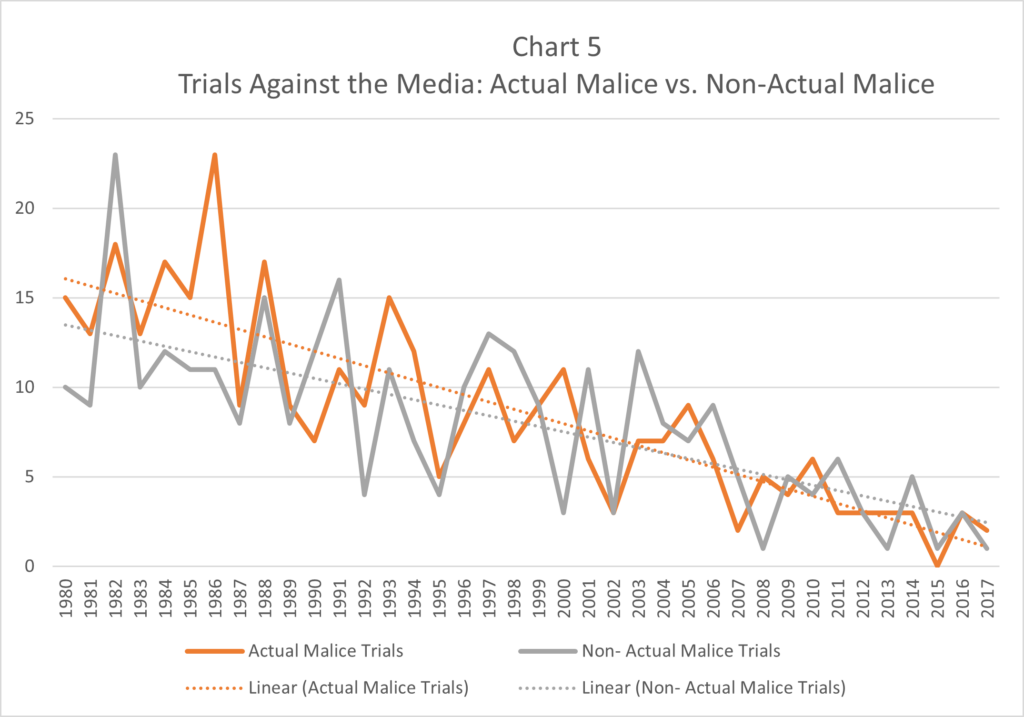
Scholars have attempted to ascertain the reasons for the sharp decline in trials and have cited a number of factors contributing to this trend. Professor John Langbein has written extensively about modern pre-trial procedures displacing the need for trial, with a particular emphasis on the evolution of the Federal Rules of Civil Procedure.[31] He notes that more expansive discovery permitted in civil litigation not only assists litigants in preparing for trial, but that with “such far-reaching disclosure of strengths and weaknesses of each side’s case, discovery often has the effect of facilitating settlement. In such cases, discovery serves to displace rather than to prepare for trial.”[32] With more extensive discovery, sometimes in the form of one party “seek[ing] costly information of marginal relevance,” comes higher costs, particularly with the increased prevalence of e-discovery.[33] Thus, “[t]he prospect of bearing these costs pressures the parties continually to recalculate the comparative advantages of settlement and trial. The greater the investment that either side has made in pretrial investigation, the greater is the incentive to avoid the risk of total loss that can result at trial.”[34]
Also, judges have also been increasingly involved in case management from the very beginning of cases and now have an express role in facilitating settlement at pretrial conferences.[35] Some have observed a link between a judge’s caseload pressure and court-generated pressure to settle.[36] Alternative Dispute Resolution procedures have increased in popularity and, in one survey of civil attorneys and judges, mediation ranked significantly higher than trials and arbitrations in predictability, speed, cost effectiveness, and fairness.[37] Further, the dearth of trials has led to fewer litigation attorneys with trial experience, and those attorneys lacking trial skills may be tempted to settle even when a trial would be good for their client.[38]
There is also evidence that more extensive discovery has led to the greater use of motions for summary judgment, with some litigators believing that “discovery’s primary use is to develop evidence for summary judgment, not to prepare for trial.”[39] Certainly, there are commentators who are concerned that the Supreme Court has, in enunciating a plausibility standard for federal pleading in Ashcroft v. Iqbal[40] and Bell Atlantic Corp. v. Twombly,[41] and a higher burden for federal plaintiffs in the 1986 Celotex trilogy,[42] displaced the role of the jury.[43] Professor Langbein has expressed the view that “[a]part from such cases [where pretrial motions reveal a case to be meritless], the main reason that the jury is disappearing is that litigants who are entitled to demand trial decide to settle, either because they no longer need a trial, or because they cannot afford it.”[44]
Another explanation for the general decline in trials is increasing corporate fear of enormous jury awards. In complex cases, the size of potential jury awards and the uncertainty of outcome tends to push risk-averse corporate defendants towards settlement.[45] And the “prospect of punitive damages also leads defendants, especially corporations, to avoid trials.”[46] Although it is beyond the scope of this report to analyze fully the reasons behind the general decline in all civil trials,[47] and the reasons for the declines may vary by practice area, it is the aforementioned concern about enormous and unpredictable jury awards that perhaps most resonates among news media defendants. Page one of the MLRC report cited by Justice Gorsuch and Professor Logan discusses “two major earthquakes” that shook the media bar in 2016 and 2017.[48] The first was a $140 million verdict in the invasion of privacy litigation brought by professional wrestler Hulk Hogan against the website Gawker, in Bollea v. Gawker Media, LLC.[49] The award was the second largest ever against a media defendant, forced Gawker into bankruptcy and liquidation of its assets, and ultimately the company settled the case in bankruptcy for $31 million.[50]
Media defendants take the prospect of devastatingly large verdicts, like the one in Bollea, very seriously when weighing whether to settle a case before trial. Lest one need proof of this point, just a year later, ABC entered into a nine-figure settlement in a case involving its reporting on so-called “pink slime,” the slang term for “lean finely textured beef,” a product used by the beef industry.[51] One of the producers of the product, Beef Products, Inc., sued ABC over a 2012 investigative report referring to the product as “pink slime,” claiming that the report caused people to believe the product was unsafe, not nutritious, and not real beef.[52] The case settled three weeks into the trial, which had been scheduled for eight weeks.[53] Months later, it was revealed in an ABC quarterly financial report that ABC had paid a $177 million settlement during the relevant period, and follow-up reporting revealed that insurance company contributions very likely raised the total amount of the settlement significantly higher.[54] Even at $177 million, MLRC is not aware of a higher settlement of a defamation or related tort case against the media.[55]
In short, the reality of the decline in all civil trials – whatever its actual causes – is very much disconnected from the legal nuances of libel law. As one scholar put it, “‘in American civil justice, we have gone from a world in which trials, typically jury trials, were routine, to a world in which trials have become “vanishingly rare.”[56]
C. The Actual Malice Standard Helps News Media Defendants in Some Cases, But Not as Frequently as Critics of New York Times Co. v. Sullivan contend.
Critics of Sullivan point to MLRC data in their attempt to demonstrate that the actual malice standard has evolved into “an effective immunity from liability.”[57] Its chief academic critic has said that MLRC data shows that “the combination of substantive, remedial, and procedural protections imposed by New York Times and its progeny are having the intended prophylactic effect.”[58] But when one looks behind the data on which such assertions are based, the cause-and-effect relationship between actual malice and the observed phenomenon becomes decidedly attenuated.
1. Trends on Appeal from Trial
While critics of Sullivan point to plaintiffs’ relatively low rate of success on appeal, they ignore those awards that are not appealed or are settled prior to appeal,[59] scenarios in which the plaintiffs keep their jury award or settle for a portion of it to avoid the uncertainty of appeal. Between 2000 and 2017, 33 of 70 (47%) of the awards that survived post-trial motions were not appealed or were settled.[60] Moreover, plaintiffs succeed at a much higher rate than defendants at trial, with plaintiffs winning 58.5% of media trials over the decades.[61] And over the decades, plaintiffs have won media cases tried under the actual malice standard at a rate (56.6%) only slightly lower than those tried under less rigorous standards such as negligence (60.6%).[62]
Media defendants do well when appealing plaintiffs’ verdicts, but the actual malice standard only helps them some of the time, and the data does not support the notion that actual malice has become a more potent weapon over the decades. Indeed, as seen below in Table 2, in the 1980s and 1990s, plaintiffs that tried their case under the actual malice standard had a significantly lower chance of success on appeal. But this has not been the case in the period between 2000 and 2017, when plaintiffs in actual malice cases did better on appeal than cases tried under negligence and other legal standards.
Table 2: Plaintiffs’ Success on Appeal of Awards
Actual Malice vs. Non-Actual Malice Trials.

While Justice Gorsuch posits that the actual malice standard has “evolved” into “an effective immunity from liability,” the data shows that plaintiffs have won 9 out of 19 (47.4%)[63] appeals of awards under the actual malice standard since the beginning of the 2000s, a far cry from “immunity.”
2. Actual Malice’s Impact in Cases Against Major News Media Entities During the Most Recent Decade.
a. Libel Suits Brought Against Leading News Media Companies Since 2009
In connection with this White Paper, MLRC sought to gather fresh information from major news media companies concerning their success on dispositive motions in libel cases, and more specifically the applicability and success rate of raising the actual malice standard in such motions. We also sought to ascertain the final disposition of those cases that were no longer pending trial or appeal. We sought this data because most of MLRC’s pre-existing data only tracks media trials and not the vast majority of media cases that never make it to trial. For this new study (the “Main Study”), we asked major news media companies to complete a survey about each of the non-pro-se libel complaints they had received since 2009.[64] Most of the companies asked to participate agreed to do so, and 16 companies/news organizations participated: Advance Publications, the Associated Press, Bloomberg News, CBS (CBS News and owned and operated television stations), the Chicago Tribune, Dow Jones (publisher of the Wall Street Journal), Fox News, Gannett (USA Today, the Arizona Republic, the Detroit Free Press and Indianapolis Star only), Hearst, the Los Angeles Times, NPR, the New York Times, ProPublica, Reuters, Tegna, and the Washington Post. In total, we analyzed 246 cases and 177 dispositive motions filed in those cases.
Separately, we sought to gather data on non-pro-se libel lawsuits against the five major television and cable news networks through a methodology using mostly publicly available information, as well as material that MLRC has compiled over the years, to identify and analyze cases brought against them since 2011.[65] For this alternative data set (the “TV News Study”), with help from paid research assistants, we identified and tracked results of cases brought against ABC News/ESPN, NBC News (including MSNBC and Telemundo), CBS News, the news operations of owned and operated television stations of the aforementioned networks, CNN and Fox News.[66] For this research method, where a complete picture of the outcome of a case could not be ascertained through publicly available information, such as online dockets like PACER, electronic research services like LexisNexis, and news websites, details regarding cases were occasionally obtained by speaking with lawyers with knowledge of the cases. While identifying the relevant lawsuits against these networks using this research method was not as accurate as surveying the companies directly, we thought it worth examining whether the data obtained in this manner, and focusing on television news, was materially different from the data obtained from the Main Study. We identified and examined 78 libel cases filed against these companies during the 2011 to 2021 timeframe, in which 62 dispositive motions were filed by the news media defendants. In both studies, early-stage motions, particularly motions to dismiss, greatly outnumbered summary judgment motions.[67] This appears to reflect a trend in which most libel cases are either dismissed or settled in the pre-discovery phase, with fewer cases proceeding to discovery and summary judgment motions.[68] Final dispositions in our studies are discussed in more detail in Section E supra. Relevant findings from both the Main Study and the TV News Study will be included in the discussion below and in additional tables provided in Appendices II & III.
b. Actual Malice Was Decisive in Only a Small Share of the Dispositive Motions Filed.
Out of 177 dispositive motions brought by our sample of news media defendants, they prevailed in 75% of those motions (including results on appeal). But, as shown in Table 3, only 16% of the motions[69] were defense wins (also including appeal) on the issue of actual malice, very much refuting the view that it is Sullivan which is driving these defense victories prior to trial. In fact, defendants in our survey won more often because the plaintiff could not carry its burden of proving falsity and/or the court found that the allegedly libelous statements were substantially true (22% of defense dispositive motions). That is particularly noteworthy in the 10 of 28 (36%) actual malice wins in which the defendant also won because of the plaintiff’s failure to prove material falsity since, by definition, the plaintiff cannot prove a defendant published despite reckless disregard of the truth, if it cannot establish that the challenged statements were even false. In those cases, the defense wins on actual malice were often superfluous[70] and, for that reason, the centrality of Sullivan as a foil in those cases is even more attenuated. In Table 4 below, we break down motion success by motion type, and include statistics on the instances in which the issue of actual malice and falsity/substantial truth were decided.[71] Defendants did better on dispositive motions in cases that are now final, winning 84% of such motions, including appeals. But again, motion wins on actual malice lag behind, with defendants winning only 18% of dispositive pre-trial motions on the issue of actual malice.
Table 3: Main Study – Detailed Results on Dispositive Motions –
Active and Final Cases, Including Appellate Results[72]

In the TV News Study, news media defendants were not as successful, winning only 57% of dispositive motions. But, more importantly, the percentage of motions won on actual malice was similar to the Main Study, with defendants winning only 19% of dispositive motions on actual malice grounds. In this television news data set, 7 of 12 (58%) defense wins on actual malice were accompanied by a win on the issue of substantial truth/material falsity which, for the reasons stated above with respect to the Main Study, further diminishes the impact of the actual malice standard in those cases.[73]
So, if these defendants are not winning primarily on the issue of actual malice, what grounds are they winning on? In our survey, those grounds included most prominently, in addition to substantial truth (or failure to demonstrate material falsity): the common law fair report privilege, the common law “of and concerning” requirement, the common law and/or constitutional “opinion” defenses (i.e., the challenged statement was not reasonably capable of being proven false or would not be construed by a reasonable reader/viewer as a statement of fact), lack of personal jurisdiction, and statute of limitations defenses.[74] Indeed, the most commonly used libel-specific defenses, applicable to both private and public figures, collectively protect the freedom of the press and the freedom of speech by narrowly construing what types of content can be deemed actionable, all apart from the actual malice standard.
Under the common law fair report privilege, for example, the “publication of defamatory matter concerning another in a report of an official action or proceeding or of a meeting open to the public that deals with a matter of public concern is privileged if the report is accurate and complete or a fair abridgement of the occurrence reported.”[75] It serves to “promote[ ] our system of self-governance by serving the public’s interest in official proceedings, including judicial proceedings.”[76]
The common law “‘of and concerning’ or specific reference requirement limits the right of action for injurious falsehood, granting it to those who are the direct object of criticism and denying it to those who merely complain of nonspecific statements that they believe cause them some hurt. To allow a plaintiff who is not identified, either expressly or by clear implication, to institute such an action poses an unjustifiable threat to society.”[77] Because the requirement serves to “protect[] the free flow of ideas on matters of public concern” and “to ensure the vigor and . . . the variety of public debate,” it has assumed constitutional proportions as well.[78]
The tenet that speakers cannot be held liable for their opinions, as opposed to their false and defamatory statements of fact, is almost as American as apple pie.[79] Courts around the country therefore recognized both a constitutional and common-law-based privilege that protects expressions of opinion from defamation liability.[80] As Justice Alito explained most recently in his dissent from the denial of certiorari in National Review, Inc. v. Mann, the “constitutional guarantee of freedom of expression serves many purposes, but its most important role is protection of robust and uninhibited debate on important political and social issues. If citizens cannot speak freely and without fear about the most important issues of the day, real self-government is not possible.”[81]
The point is that, in the interest of free and open public debate, the law robustly protects expressions of opinion, fair and accurate accounts of government proceedings, and generalized criticisms of institutions and government, which are often disseminated through the media by way of news content, investigative journalism, op-eds, and punditry. The targets of these criticisms and investigations often do not like how they are portrayed in the media, and sometimes they sue. While the actual malice standard is essential to provide the press the breathing room to make unintentional, good faith mistakes during the course of reporting about public officials and public figures,[82] our research of libel cases involving major news media organizations shows that, more often than not, cases against these companies are dismissed on one of the larger array of speech-protective libel defenses (most of which are creatures of the common law) and procedural rules. In these cases, the actual malice standard is sometimes the winning argument, but not in the majority of cases. That does not diminish its importance in safeguarding public debate by providing a measure of protection to the press and other “good faith” critics of public persons when they make honest mistakes, it does put the role and impact of that protection in its proper context.[83]
D. Libel Complaints Against the Media Have Not Gone Down in Recent Years
Critics of Sullivan seem to assume that the reduction in the number of media trials must necessarily correlate with a reduction in litigation and the number of defamation lawsuits.[84] However, the available data indicates that the number of libel complaints brought against the media has actually increased in recent years. MLRC pursued three methodologies of examining trends in libel cases filed against the media each year.
First, while it is very difficult to find news media case filings in the haystack of state and local courthouses, federal libel cases are usually filed with a Nature of Suit (NOS) Code 320 (Libel, Slander & Assault) entered on a case information form by the plaintiff’s lawyer, which somewhat narrows the ballpark where federal claims against the media can be found.[85] MLRC downloaded all federal civil case records from 1970-2020 from the Federal Judiciary Center’s website that bear the 320 NOS code. A comprehensive review of the approximately 37,000 court dockets represented by this data set to confirm the specific nature of each case was not practicable within the limitations of this study. Nevertheless, the MLRC has observed over the four decades of its existence that, in defamation lawsuits against the institutional media, a media organization rather than an individual is most commonly named as the lead defendant. The MLRC therefore reviewed the case name included in each of the approximately 37,000 records and attempted to ascertain whether the named defendant was an identifiable media entity. In this manner, the MLRC sought to develop a subset of records that is representative of the defamation lawsuits included in the overall data set while excluding as many non-defamation cases as reasonably possible. The final data set included 1,871 cases with a known media defendant. We think this data provides a useful proxy for media defamation cases filed, at least in federal court, and year-to-year trends represented by these figures.[86]
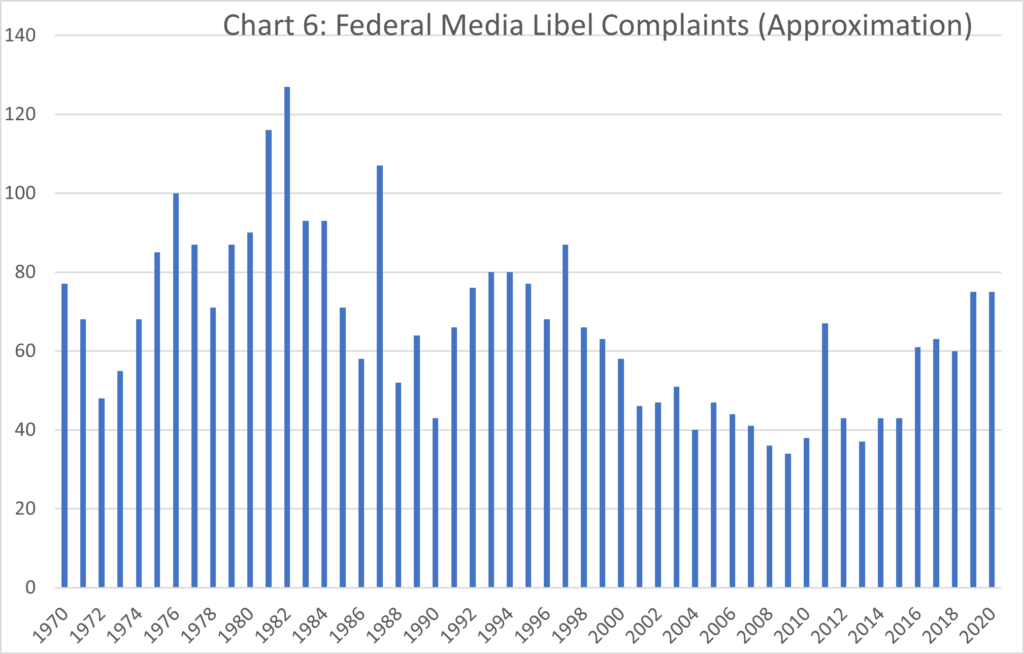
As can be seen in Chart 6,[87] federal media libel cases have had their ups and downs over the decades, with visible spikes in the 1980s. The apparent increase from the early part of the 1970s to the late 70s and early 80s is consistent with what Professor Rodney A. Smolla wrote in 1983, almost 20 years after Sullivan and more than nine years after the Supreme Court decided Gertz v. Robert Welch, Inc.[88]: “America is in the midst of a rejuvenation of the law of libel. Only a decade ago, the law of defamation appeared to be headed for obsolescence. Yet an astonishing shift in cultural and legal conditions has caused a dramatic proliferation of highly publicized libel actions brought by well-known figures who seek, and often receive, staggering sums of money.”[89]
Professor Smolla catalogued the libel cases that permeated the headlines in the early 1980s, such as those involving General William Westmoreland, Carol Burnett, Wayne Newton, Elizabeth Taylor, Norman Mailer, Ralph Nader and others. In his article, Professor Smolla theorized about the reasons for the “increase in the number and prominence of libel suits”[90] and a “tremendous increase in the judgments awarded by juries” in the 1980s, attributing it not – of course – to the more restrictive actual malice standard introduced in Sullivan, but rather to, inter alia, shifts in the culture and developments in other areas of tort law that normalized strict liability and recovery for emotional injuries.[91] If nothing else, if one theorizes – as critics of the actual malice standard seem to – that a decline in libel cases today is caused by Sullivan’s lasting impact, it is difficult to square that theory with the apparent rise in libel cases in the 1980s, long after Sullivan had made its mark.
More importantly, the data does not support a straight line of decline in media libel cases in the most recent decade as Sullivan’s critics assume based, it appears, solely on data concerning defamation trials.[92] After a slowdown in the late 2000s and early 2010s, there seems to have been a resurgence in more recent years after the political climate grew hot during the Trump era. Just like the surge in the 1980s, one need not dig much deeper than recent headlines to document myriad politically charged suits brought during the Trump years, albeit a wave not as large as the one in the eighties. These cases include: at least ten by former Congressman Devin Nunes against various media outlets; suits arising out of a 2019 incident on the national mall in which several students, including one wearing a ”Make America Great Again” hat, were filmed standing face-to-face with a Native American activist; suits brought by Trump-aligned former Arizona Sheriff, Joe Arpaio; suits brought by former coal executive, Don Blankenship, who claimed he lost a senate race because he was inaccurately referred to as a “felon” by the media (having only been convicted of a misdemeanor); and suits brought directly by the Trump campaign itself against media outlets that the then-president vocally attacked as “enemies of the people.”[93]
The federal case research does not stand alone. Next, we examine complaints from 12 of the 16 media entities that participated in our Main Study. We exclude four of the companies in Chart 7 (below) because they told MLRC that they were not confident that they could locate all case files from the earlier years covered by our survey. A table showing a distribution of complaints by year for all 16 media entities as well as the smaller group of 12 are included in Appendix II, Table G, infra, at 131. The Main Study, as a whole, consisted of 59% state cases, and 41% federal cases.[94]
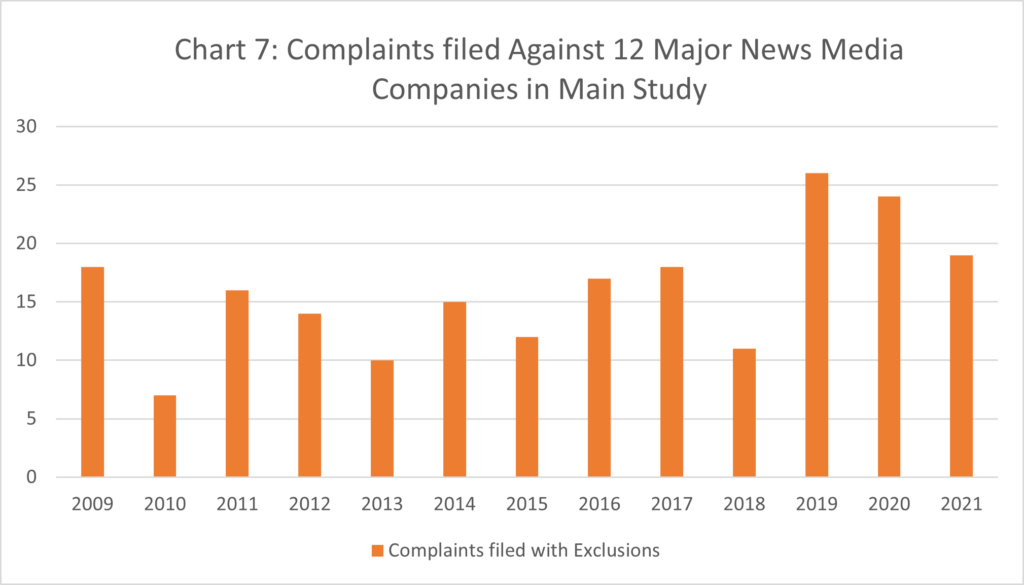
Finally, we looked at the distribution of complaints examined in our TV News Study, which is provided in Appendix III, Table L, and depicted below in Chart 8. In the TV News Study, the proportions of state and federal cases were the reverse of those in the Main Study: 59% federal and 41% state.[95]
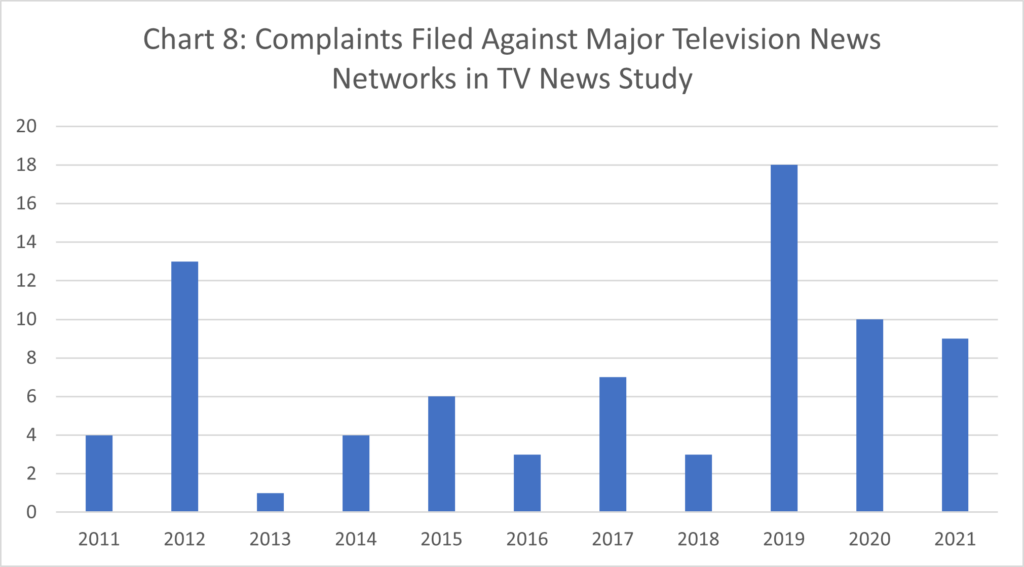
To be sure, these are imperfect methodologies for estimating trends in the number of media complaints, but it is noteworthy that, in all three data sets, 2019 is the high-water mark for complaints filed during the recent decade. Moreover, the number of complaints in all three sets tended to be higher in the last few years of the decade as opposed to the earlier part of the 2010s. With these three methodologies all pointing in the same direction, we think this evidence is consistent with our observations of more politically driven lawsuits being filed over the last few years, with anecdotal reports from MLRC members that they had seen an uptick in cases during the Trump era. The data is certainly not consistent with a theory that the actual malice standard, established in the 1960s and 1970s, has so frustrated plaintiffs that they do not even bother to sue the news media anymore.
E. Settlements Are the New Verdicts.
In MLRC’s trial study, we have previously documented major shifts over the years in the number of settlements. Plaintiff trial wins, after all appeals, have been relatively stable over the years: 18.9% total wins and 6.7% partial wins over the decades.[96] The shift has been from total defense wins to settlements such that, while entire defense victories declined from 62.4% in the 1980s to 42.6% in the 2010s, settlements rose from a mere 7.5% of cases in the 1980s to 31.9% in the 2010s.[97]
But, as has been discussed above, trials are increasingly rare because there has been an across-the-board shift in civil litigation in the United States over the decades since Sullivan was decided. As one federal district judge put it, “[t]rials have gone the way of landline telephones – useful backups, not the instruments primarily relied upon, if ever they were.”[98] For all of the reasons explored above in Section B, lawsuits resolved on either dispositive motion or by settlement are now the norm, and trials are the exception.[99]
None of the final cases in the Main Study and TV News Study went to trial; results of these cases are shown in Table 4 & 5 below:
TABLE 4: Final Disposition – Main Study

TABLE 5: Final Disposition – TV News Study

The final outcomes in the two studies are very similar. The percentage of cases ending with a defense win on a dispositive motion[100] in the Main Study and TV Study, were 51% and 48%, respectively. The next most common outcome was “Settled,” 27% in both of the studies. Plaintiffs voluntarily dismissed their complaints in 16% of the cases in the Main Study and in 18% of the cases in the TV News Study. Less common final dispositions are noted in Tables 4 & 5.
One special tabulation is also shown in the rightmost columns of Tables 4 and 5, which is final dispositions sorted to include only cases where the defendant did not fully succeed on a motion to dismiss, i.e., the motion was denied or it was only partially granted. In the vast majority of those cases, the defendant ended up settling the case: 75 % of the time in the Main Study and 73% of the time in the TV News Study. This appears to reflect a new reality among many news media defendants, who see a pre-discovery motion as cost-effective, but the expense, burden and uncertainty of proceeding to discovery and further motion practice outweighed by the benefits of settling the case.
Settlement agreements are almost always confidential and so it is not possible to quantify how much is typically paid or if a payment is part of the settlement.[101] When payments are made, we know they run the gamut, from nuisance values to the one jaw-droppingly large settlement in a case that is included in the TV News Study: ABC’s settlement with Beef Products, Inc., over ABC News’ reporting on so-called, “pink slime,” reported to have been $177 million or more.[102]
When trials were more prevalent and settlements more uncommon, it was possible to give a more meaningful calculation of how often plaintiffs “succeeded” in litigation against the news media. The first studies in this area were done by Professor Marc Franklin, who looked at appeals in reported media cases between 1977 and 1980 and found that plaintiffs succeeded with an award of damages fully affirmed in only 5% of media cases that were appealed.[103] Otherwise, 66% of the appeals were defense wins, either after dispositive motion or after trial, and 28% of the appeals were remands, in which either side could still prevail in further proceedings.[104] At the time, settlements were thought to be less common or involved small amounts when they did occur.[105] But clearly, even then, plaintiffs succeeded in only a small number of cases against the media.
The MLRC (known as the Libel Defense Resource Center until 2003) continued Franklin’s work over the decades, but primarily tracking cases which made it to trial; and MLRC had not, prior to this report, tracked cases from complaint to final disposition. When plaintiffs did succeed at trial, MLRC kept track of the results and calculated the awards of damages, which, after appeals, averaged under a half million dollars in the 1980s and 90s and went up to well over a million dollars after the 2000s.[106]
In our Main Study and TV News Study, cases resulted in a settlement in 27% of the cases. One of these settlements was for more than $177 million, others may have been comparable to average awards at trial, yet many others were likely for nuisance value or other non-monetary consideration. Admittedly, there is much we do not know about these settlements, but since Justice Gorsush, in his Berisha dissent, puts such an emphasis on the assumption that the legal environment has gotten worse for plaintiffs over time, it is worth pointing out that we do not know whether plaintiffs are faring any worse today than they did in the late 1970s, when only 5% of reported media case appeals were an affirmance of a trial award. We know that when a jury does render an award of damages today, the amount is much higher than those awards issued in the late 1970s, but we do not truly know how often plaintiffs “succeed,” however that can be measured. This is because so many “awards” now take the form of confidential settlements. Needless to say, it would be inappropriate to reverse 58 years of constitutional precedent based, in significant part, upon speculative assumptions about plaintiff success rates, especially when the available data cuts against those assumptions.
F. Conclusion
There is no evidence that implementation of the actual malice standard in New York Times Co. v. Sullivan and later decisions has led to a reduction in defamation trials against the news media, or that the number of trials is a benchmark for plaintiff success in such cases. Indeed, the number of trials in all civil litigation, including media cases not tried under the actual malice standard, have all declined at roughly the same rate. Moreover, while defendants in news media cases have always had a good success rate on appeals and dispositive motions, actual malice only helps defendants some of the time. In our research on libel litigation involving major news media companies, actual malice was not the predominant reason that defendants were successful on dispositive motions, with other defenses such as substantial truth, opinion, the fair report privilege and the “of and concerning” requirement collectively playing a much larger role in defendant success. Libel complaints against the media have not gone down, and if anything, they have increased in recent years. And, just like in other litigation practice areas, trials in media defamation cases are all but extinct, but plaintiffs often recover – when they have a meritorious case – through settlement.
APPENDIX I: Trial Tables
TABLE A: Total Media Trials vs. Total Federal Civil Trials

TABLE B: Trials Against the Media:
Actual Malice vs. Non-Actual Malice

TABLE C1, C2, C3: Revisions of 2018 Report Table 12A:
Appeals From Verdicts – Defendants
with Actual Malice Only and Non-Actual Malice Breakdowns

TABLE D: Media Defense Wins at Trial by Legal Standard

TABLE E: Federal Media Complaints from 1970-2020 (Approximation)

Appendix II: The News Media Libel Case Study (Main Study)
METHODOLOGY
We asked major U.S. news media organizations to participate in a survey seeking information on libel lawsuits instituted against them from 2009 to 2021. Most of the companies asked to participate did so and responded to the survey. The sixteen participating media organizations included: Advance Publications, the Associated Press, Bloomberg News, CBS (CBS News and owned and operated television stations), the Chicago Tribune, Dow Jones (publisher of the Wall Street Journal), Fox News, Gannett (USA Today, the Arizona Republic, the Detroit Free Press and Indianapolis Star only), Hearst, the Los Angeles Times, NPR, the New York Times, ProPublica, Reuters, Tegna, and the Washington Post.
Responding news media companies were asked to provide the following information with respect to each non-pro se libel complaint received from 2009 to 2021: year, the forum (including whether the case was in federal or state court), the public/private status of the plaintiff, a description of the results of dispositive motion practice, whether the case was still pending or final and, if final, the disposition. Responses were collected from late December 2021 through mid-January 2022 and updates to active cases were generally not possible once surveys had been collected and tabulated. A few more specifics with respect to the questions follow:
Public/Private Status of Plaintiff – Respondents were asked to identify, if known, the status of the plaintiff as a public official, public figure or private figure. The survey instructed that a response was appropriate if the status was decided by the court or clear or uncontested in the pleadings.
Dispositive Motion Results – Respondents were asked to list each Anti-SLAPP, Motion to Dismiss, and/or Motion for Summary Judgment filed in each case. For each such motion, respondents were asked whether the ultimate outcome of the motion was a win or a loss, if the issues of Actual Malice and/or Falsity/Substantial Truth were decided, and whether the ultimate outcome was a win or a loss (or not applicable) on that issue. Also, for each result, on the entire motion and on the issues of Actual Malice and Falsity/Substantial Truth specifically, the respondent was asked to identify the highest court to decide the issue, i.e., the trial court, an intermediate appellate court, etc. There was extra space provided in the survey form to describe dispositive motion practice more complex than the above. Occasionally, an outcome was described as a “Partial” win on certain issues, but not all of the libel claims were dismissed entirely, and the result was recorded as such. In the results, partial wins are not tabulated as defense wins. If an appellate court reversed and remanded a decision for further consideration by the trial court, that motion was not tabulated in the results, because such outcomes were a deemed a nullity in terms of the decision. Moreover, motions that were “pending” did not count as a motion for the purposes of our calculations, but were noted in our records for follow-up in the future.
Final or Pending – Respondents were asked to indicate whether each case was Final, Pending Trial or Pending Appeal.
Final Disposition – If a case was final, respondents were asked to indicate the final result of the case. The choices provided were: Win on Dispositive Motion, Win on Procedural Motion (e.g., jurisdiction or failure to prosecute), Settled (Regardless of whether payment involved), Voluntarily Dismissed, Defense Win at Trial, Defense Loss at Trial or Other. If the response was “Other,” the respondent was provided an opportunity to include a written explanation.
If a survey response was internally inconsistent, non-responsive as to questions requiring an answer, or was otherwise ambiguous, MLRC either contacted the respondent with follow-up questions to clarify the survey response or, when applicable, reviewed publicly available decisions on a dispositive motion/appeal to clarify an omitted or ambiguous answer.
TABLE F: Main Study Demographics

TABLE G: Complaints by Year: Main Study

Note: The column headed with “All Complaints” shows the distribution by year of all 16 companies/media entities that participated in our Main Study. The column headed with “Complaints Filed With Exclusions” excludes four survey participants who indicated that they were not confident that they could locate all records from the earlier years covered by the survey.
TABLE H: Defendant Success on
Dispositive Motions (Including Appeal) – Main Study

TABLE I1 & I2: Detailed Results on
Dispositive Motions (Including Appeal) – Main Study[107]

TABLE J: Final Disposition – Main Study
With Special Breakdown of Cases in Which Defendant
Lost or Partially Won a Motion to Dismiss

APPENDIX III: The TV News Study
METHODOLOGY
The primary distinction in the methodology used to collect data in the TV News Study (as compared with the Main Study) is that media companies did not participate in gathering information for the TV News Study. Rather, data was gathered on non-pro-se lawsuits using mostly publicly available information and information that MLRC has compiled over the years. In the TV News Study, MLRC sought the same case information sought in the Main Study but with respect to libel lawsuits brought against ABC/ESPN, NBC News (including MSNBC and Telemundo), CBS News, owned and operated television stations of the aforementioned networks, CNN and Fox News. MLRC, with help from paid research assistants, identified and tracked results of cases brought against these companies since 2011. Cases were identified by searching through the MediaLawDaily (the “Daily”), a daily email newsletter that the MLRC staff compiles and shares with MLRC members. The Daily includes links to breaking news and generally includes new libel cases brought against the media, as well as related decisions in those cases, when reported in one the of dozens of sources that MLRC reviews each day. Due to the limited number of years of the Daily that MLRC had stored, this research was limited to 2011 to 2021.
Paid research assistants were utilized to respond to the same survey questions used in the Main Study, but using online dockets like PACER, electronic research services like LexisNexis, and news websites. In occasional instances where a research assistant was unable to determine the answer to all of the survey questions, MLRC contacted lawyers with direct knowledge of the case to acquire the missing information. If a survey form could not be completed accurately, the case was excluded from the TV News Study. Research for the TV News Study was completed by mid-January 2022 and updates to active cases were generally not possible after this time frame.
Once MLRC received the completed survey forms, they were checked for internal inconsistencies, and non-responsive or ambiguous answers. Where such questions arose, MLRC followed up with the research assistant to clarify the survey response, or, when applicable, reviewed the publicly available decision on a dispositive motion/appeal to clarify an omitted or ambiguous answer.
TABLE K: TV News Study Demographics

TABLE L: Distribution of Complaints by Year – TV News Study

TABLES M1 & M2: Detailed Results on
Dispositive Motions – TV News Study

TABLE N: Final Disposition – TV News Study
With Special Breakdown of Cases in Which Defendant
Lost or Partially Won a Motion to Dismiss

[1] 141 S. Ct. 2424 (July 2, 2021) (revised July 29, 2021). Seethe Supreme Court’s website for a redline document showing revisions. https://www.supremecourt.gov/opinions/relatingtoorders/20
[2] Logan, Rescuing Our Democracy by Rethinking New York Times v. Sullivan, 81 Ohio St. L. J. 759, 808-10 (2020) (citing MLRC 2018 Report on Trials and Damages (“MLRC 2018 Report”)).
[3] 141 S. Ct. at 2428; see also id. (citing Logan, supra, at 808-10).
[4] We use the term “defense” here without regard to which party has the burden of proof on each issue.
[5] Eighty-eight percent (88%) of the trials in MLRC’s study include a defamation claim, but some claims are based upon invasion of privacy theories of liability, such as false light, and other torts claims against the media. See MLRC 2018 Report, at 25.
[6] Id. at 93. Media-affiliated individuals include: “individual journalists, editors, authors and other individuals involved in the creation and dissemination of editorial content.” Id. at 95.
[7] Id. at 95.
[8] Id.
[9] Id. at 33 & n.15. Two additional internet trials resulted in hung juries, which are not used in most of the statistical calculations made in our reports.
[10] 141 S. Ct. at 2427.
[11] See, e.g., id. at 2425 (Thomas, J., dissenting) (citing conspiracy theories on the internet that led an armed gunman to enter a Washington, D.C. pizza restaurant and a New York Times story about a man who was smeared by rumors on the internet); id. at 2427 (Gorsuch, J., dissenting) (citing a study documenting falsehoods spread on Twitter).
[12] See Chap. 2, supra, at 93-94.
[13] See MLRC 2018 Report, at 31-33, for a full breakdown of the media types covered by our trial study, which also includes books, cable, film, music and internet websites.
[14] The results of this survey are provided in greater detail in Sections C.2.a through E, infra, and a methodology is provided in Appendix II, infra, at 128-29.
[15] See Diamond & Salerno, Reasons for the Disappearing Jury Trial: Perspectives from Attorneys and Judges, 81 La. L. Rev. 1 (2020) (“Diamond”).
[16] Smith & Macqueen, “Going, Going, But Not Quite Gone,” Judicature, Vol. 101, No. 4 (Winter 2017) (“Smith”) at 28 (citing Galanter & Frozena, The Continuing Decline of the Civil Trials in American Courts 23 (Pound Civil Justice Inst. 2011) (“Galanter II”)).
[17] See Federal Judiciary Center, Integrated Database, searched on Jan. 6, 2022 at https://www.fjc.gov/research/idb. In the FJC’s records of civil cases filed between 1970 and 1987, only 13,729 cases out of 2,820,279 were coded as 320 (Libel, Slander & Assault). On the records from 1988 to the present, only 23,493 out of 9,474,444 were similarly coded. We say approximately 3/10ths of a percent because assault cases are included in this total; moreover, libel claims are sometimes brought under codes specifying personal injury cases or under codes for related claims in a complaint.
[18] Galanter, The Vanishing Trial: An Examination of Trials and Related Matters in Federal and State Courts, J. of Empirical Legal Studies, Vol. 1, Issue 3, 459-570, 516 (Nov. 2004) (“Galanter I”)
[19] MLRC’s study on trials and damages includes data from trials in defamation, privacy and/or other related claims stemming from the collection or dissemination of news, information or entertainment that are brought against the media. See MLRC 2018 Report, supra, at 93-104 (containing detailed methodology of the MLRC trial study).
[20] The Microsoft Excel “Trend” function finds the linear trend by using the least squares method to calculate the line of best fit for a supplied set of y- and x- values.
[21] The measure of all federal civil trials used here is the federal Administrative Office’s statistic: civil terminations during or after trial in U.S. district courts. It “is not a count of completed trials but of cases that reach the trial stage.” Galanter I, supra, at 461. “Since some cases settle after trial has commenced, these figures overstate the number of completed trials.” Id. at 461 n.4. However, one of the leading researchers studying the phenomenon of the decreasing trials in the United States has called this figure: “a plausible if inexact indicator of both the magnitude and year-to-year trends in trial activity.” Id. at 461 n.6.
[22] A surge in federal case terminations during or after trial in 2007 and 2008, represented by a spike during that time frame (as seen in Chart 2), is explained in a footnote to an Administrative Office table: “These increases resulted from terminations of oil refinery explosion cases in the Middle District of Louisiana.” Judicial Facts and Figures 2010, Table 4.10 (U.S. District Courts – Civil Cases Terminated, by Action Taken). Available at: https://www.uscourts.gov/statistics-reports/analysis-reports/judicial-facts-and-figures
[23] MLRC has only collected and published data on media trials through the end of 2017.
[24] The data for the number of cases terminated during or after trial, from 1980-2000, comes from Galanter I, supra, 532-334 (Table A1 & A2). Galanter notes that those figures were drawn from Table C-4 of the annual reports of the Administrative Office of the U.S. Courts. The same data for the years 2001-2017 comes directly from those Table C-4 annual reports of the Administrative Office, available on their website at https://www.uscourts.gov/statistics-reports/analysis-reports/statistical-tables-federal-judiciary
[25] SeeEngstrom, The Diminished Trial, 86 Fordham L. Rev. 2131, 2132 (2018).
[26] MLRC 2018 Report, supra, at 23, Table 1; MLRC 2010 Report on Trials and Damages at 29, Table 4.
[27] Galanter II, supra, at 8; see id. at 6 (citing Administrative Office of U.S. Courts Annual Reports, Table C-4).
[28] See Abramson, “Westmoreland to Drop Libel Suit Against CBS: General, Network to Make Joint Announcement Today on Ending of $120-Million Legal Action,” L.A. Times, Feb. 18, 1985.
[29] See Hornblower, “Sharon v. Time Magazine In $50 Million Lawsuit,” Wash. Post, Nov. 14, 1984.
[30] The split is about 48% non-actual malice cases, 52% actual malice. See Appendix I, Table B, infra, at 124.
[31] Langbein, The Disappearance of Civil Trial in the United States, 122 Yale L. J. 522, 524 (2012) (“Langbein”).
[32] Id. at 548. This chapter will discuss settlements in media defamation cases more specifically in Section E, infra, 119-22.
[33] Id. at 552 (citations omitted).
[34] Id. (citations omitted).
[35] Id. at 559 (citing 1983 revision to Fed. R. Civ. P. 16).
[36] Id. at 560 (citing comments by the late U.S. District Court Judge Jack B. Weinstein); see also Smith, supra, at n.96 (citing Bennett, Judges’ Views on Vanishing Civil Trials, 88 Judicature 306, 308 (2005) (“Judge Mark W. Bennett has suggested that ‘federal trials court judges place far too much pressure far too often on litigants and lawyers to settle their cases,’ thereby resulting in the ‘vanishing civil jury trial.’”)).
[37] Diamond, supra, at 131-32.
[38] Elrod, Is the Jury Still Out? A Case for the Continued Viability of the American Jury, 44 Texas Tech. L. Rev. 303, 323-24 (2012).
[39] Id. at 568 (citations omitted).
[40] 556 U.S. 662 (2009).
[41] 550 U.S. 544 (2007).
[42] This trilogy of Supreme Court decisions, Celotex Corp. v. Catrett, 477 U.S. 317 (1986); Matsushita Elec. Indus. Co. v. Zenith Radio Corp., 475 U.S. 574 (1986); and Anderson v. Liberty Lobby, Inc., 477 U.S. 242 (1986), redefined the standards applicable to summary judgment motions. Among media defendants, Anderson v. Liberty Lobby is considered the most significant because it set the standard for applying actual malice on summary judgment.
[43] Thomas, The Missing American Jury 32-35 (Cambridge University Press 2016).
[44] Langbein, supra, at 572.
[45] Smith, supra, at 34 (citing Elrod, supra, and Rose, The Reasonable Investor” of Federal Securities Law: Insights from Tort Law’s “Reasonable Person” & Suggested Reforms, 43 J. of Corp. L. 77 (2017)).
[46] Smith, supra, at 34.
[47] Not to mention criminal trials, which have been in decline too. See Thomas, supra, at 2.
[48] MLRC 2018 Report, supra, at 1.
[49] Case No. 12-012447-Cl (Fla. Cir. Pinellas County, March 21, 2016). MLRC 2018 Report, at 2.
[50] Id. at 2, 12-13.
[51] Id. at 2.
[52] Id.
[53] Id. at 3.
[54] Id.
[55] Id.
[56] Langbein, supra,at 524.
[57] See Berisha, 141 S. Ct. at 2428 (Gorsuch, J., dissenting) (citing Logan, supra).
[58] Logan, supra, at 810.
[59] This was a source of error in Professor Logan’s interpretation of an MLRC statistical table showing plaintiffs’ appellate success. The oversight was that the ratio given for awards affirmed on appeal (MLRC 2018 Report, p.47, Table 12A) was divided by all awards that survived post-trial motions, including cases that settled, were not appealed, or were still pending at the time of our 2018 Report. SeeLogan, supra, at 809-10, erroneously citing MLRC data as showing that plaintiffs have a success rate on appeal of damage awards of 9.5%, when the actual statistic of success on appeal at the time our report was published was 33.3%. Justice Gorsuch had originally published Professor Logan’s incorrect statistic in an early version of his dissent, but corrected it in a July 29, 2021 revision after the error was pointed out to the Court. See 141 S. Ct. at 2428 (citing the correct statistic that 1 of every 3 jury awards, based upon 2 successful plaintiff’s appeals out of 6 from 2010 to 2017, as of the time of our report). The Supreme Court’s website contains a redline document showing the revisions. Although MLRC has not updated its trial study with new cases since the 2018 report, we have updated the cases that were then pending appeal but have since completed the appellate process. The revised number of plaintiffs’ damages awards affirmed on appeal (in their entirety) during 2010 to 2017 is 4 in 9, or 44.4%. That revised data is shown in Table C1, Appendix I, infra, at 125. It also includes additional columns showing “Completed Appeals” and “Plaintiff’s % Success on Appeal,” for clarity.
[60] See Appendix I, Table C1, infra, at 125.
[61] MLRC 2018 Report, supra, at 23, Table 1.
[62] See Appendix I, Table D, infra, at 126 (showing the inverse statistic, defense wins at trial).
[63] See Appendix I, Table C2, infra, at 125.
[64] After making initial inquiries to a few of the media companies asked to participate in this survey, 2009 was chosen as the earliest date from which those companies could reasonably retrieve case records. However, as more companies were asked to participate, we learned that four media companies were not confident that they were able to locate all records from the earlier years covered by this survey. For this reason, we generally do not try to draw conclusions about trends over time with this data and, where we do, we exclude those four companies from the data, as will be explained in Section D infra.
[65] The source of identifying cases was MLRC’s MediaLawDaily (the “Daily”), a daily email newsletter that the MLRC staff compiles and shares with MLRC members. The Daily includes links to breaking news and generally includes new libel cases brought against the media, as well as related decisions in those cases, when reported in one the of dozens of sources that MLRC reviews each day. Due to the limited number of years of the Daily that MLRC has stored, this research was limited to 2011 through 2021.
[66] Although there is overlap in two of the companies that were included in the Main Study and the TV News Study, the information provided by the companies in the Main Study was not used to identify cases for the TV News Study.
[67] See Appendix II, Table H, infra, at 131; Appendix III, Table M1 & M2, infra, at 137.
[68] See id.
[69] For the purpose of our calculations on the number of decisions and wins on dispositive motions for the specific issues of actual malice and falsity/substantial truth, we removed one case in which the defendant successfully moved for summary judgment but, after due diligence, we were unable to determine the basis for the court’s decision. This is why Table 4, below, shows only 176 motions, but Appendix II, Table H, infra, at 131, shows 177 motions.
[70] There may be instances where the court dismissed claims based on falsity with respect to some allegedly libelous statements and dismissed other statements on the grounds of actual malice. The survey questions were not detailed enough to account for this distinction.
[71] In Appendix II, Tables I1 & I2, infra, at 132, we show a horizontally oriented version of this table as well as one that includes data only from final cases.
[72] One case is removed from this table. Seenote 69 supra for an explanation.
[73] SeeAppendix III, Tables M1 & M2, infra, at 137, for more detailed results from the TV Study, including results in final cases. Arguably, whenever the court rules in favor of the defendant on alternative grounds that include actual malice, actual malice did not necessarily control the outcome. However, to keep the scope of our research manageable, we did not seek data on every alternative basis for court decisions.
[74] To keep the scope of our inquiry manageable for survey respondents, we did not poll on these issues specifically, but these defenses were mentioned in comments made in an optional section where respondents could describe the dispositive motion practice in more detail.
[75] Restatement (Second) of Torts § 611 (1977).
[76] Solaia Tech., LLC v. Specialty Publ. Co., 221 Ill. 2d 558, 585 (Ill. 2006).
[77] Blatty v. New York Times Co., 42 Cal. 3d 1033, 1044 (1986).
[78] Collins, Free Speech, Food Libel, & the First Amendment . . . in Ohio, 26 Ohio N.U.L. Rev. 1, 27 (2000) (citing Berlin, Of and Concerning, Libel Def. Resource Ctr. Bull., April 20, 1998, at 43); New York Times Co. v. Sullivan, 376 U.S. 254, 279 (1964). Justices Thomas and Gorsuch do not appear to take issue with this aspect of Sullivan. See, e.g., McKee v. Cosby, 139 S. Ct. 675, 677 (2019) (Thomas, J., concurring in denial of certiorari) (“This holding was sufficient to resolve the case.”).
[79] As Senator Daniel Patrick Moynihan famously said, “Everyone is entitled to his own opinion, but not to his own facts.”
[80] See Milkovich v. Lorain J. Co., 497 U.S. 1 (1990); Dienes & Levine, Implied Libel, Defamatory Meaning, and State of Mind: The Promise of New York Times Co. v. Sullivan, 78 Iowa L. Rev. 237, 265-66 (1993).
[81] 140 S. Ct. 344, 346 (2019) (Alito, J., dissenting from denial of certiorari).
[82] See Chap. 4, infra, Section II.B. at 157-65.
[83] 376 U.S. at 279-83.
[84] See Logan, supra, at 810 (“as an empirical matter, libel actions against media defendants are rarely litigated”).
[85] This is generally true, although some plaintiffs file defamation suits under personal injury NOS codes.
[86] There are certainly limitations to this methodology. For example, the lead defendant in a media case might be a reporter’s name, and multiple defendant names are not provided in the records. A media company can also be involved in an ordinary commercial or employment dispute involving libel where its publishing function is not at issue, and media companies can also be named as defendants in personal injury assault cases.
[87] A table including the data represented in this chart is included in Appendix I, Table E, infra, at 127.
[88] 418 U.S. 323 (1974).
[89] Smolla, Let the Author Beware: The Rejuvenation of the American Law of Libel, 132 U. Pa. L. Rev. 1 (1983). See also Ollman v. Evans, 750 F.2d 970, 993 (D.C. Cir. 1985) (Bork, J., concurring) (describing 1980s phenomenon of “a freshening stream of libel actions, which often seem as much designed to punish writers and publications as to recover damages for real injuries” and which therefore “threaten the public and constitutional interest in free, and frequently rough, discussion.”).
[90] Smolla, supra, at 4 (citing Daniels, Pre-Complaint Phase: Avoiding Litigation—Preventative Counseling, in Libel Litigation 1981, at 19 (noting “[t]he increasing number of [libel] suits filed”)); see also Smolla, supra, at 2-4 & nns. 8-22.
[91] Smolla, supra, at 14-35.
[92] See Section B, supra, at 100-08.
[93] See Chap. 4, infra (discussing these and other contemporary cases).
[94] Appendix II, Table F, infra, at 129.
[95] Appendix III, Table K, infra, at 135.
[96] MLRC 2018 Report, at 62-64.
[97] Id.
[98] Hornby, The Business of the U.S. District Courts, 10 Green Bag 2d 453, 468 (2007).
[99] See Section B, supra, at 105-08.
[100] In this table, “dismissed on dispositive motion” means the case was dismissed on the merits, while “dismissed on procedural motion” was not on the merits, sometimes for lack of personal jurisdiction. In the tables showing the outcome of dispositive motions (Table 3 supra; Table H, I1, and I2, Appendix II; M1 & M2, Appendix III), both on the merits and non-merits procedural dispositive motions are included.
[101] To head off potential confidentiality issues arising out of our Main Study, respondents were asked only to acknowledge that a settlement had been reached, regardless of whether payment was involved.
[102] See Section B, supra, at 107-08.
[103] Franklin, Suing Media for Libel, Am. Bar Found. Res. J., Vol. 6, No. 3, 779, 803 (Summer 1981).
[104] Id.
[105] Id. at 800.
[106] MLRC 2018 Report, at 50.
[107] These tables exclude one case in which the basis for the court’s decision is unknown.
The author is a staff attorney at the Media Law Resource Center, where he serves as editor of MLRC’s 50-State Surveys and several of MLRC’s triannual bulletins, which include periodic reports on MLRC’s multi-decade study of media trials and damages. He is also the organizer of MLRC’s annual Legal Frontiers in Digital Media conference. Prior to joining MLRC in 2011, he was a litigator for ten years at the New Jersey law firm, Lowenstein Sandler. The author gratefully acknowledges the enormous contributions of Jeff Hermes and Lee Levine to the new research conducted for this chapter, which would not have been possible without their herculean efforts.